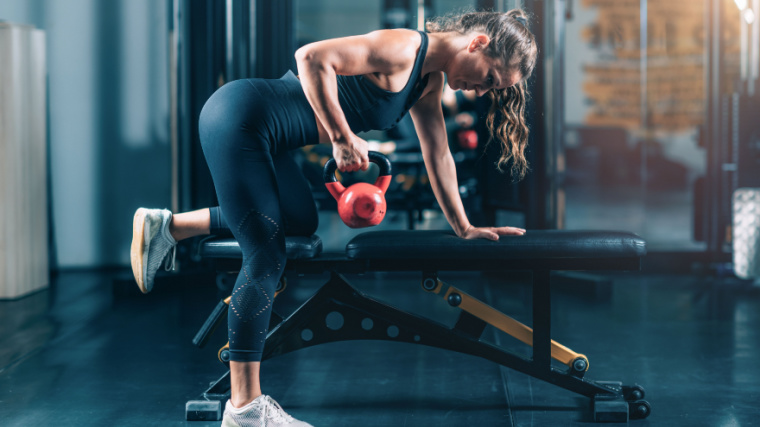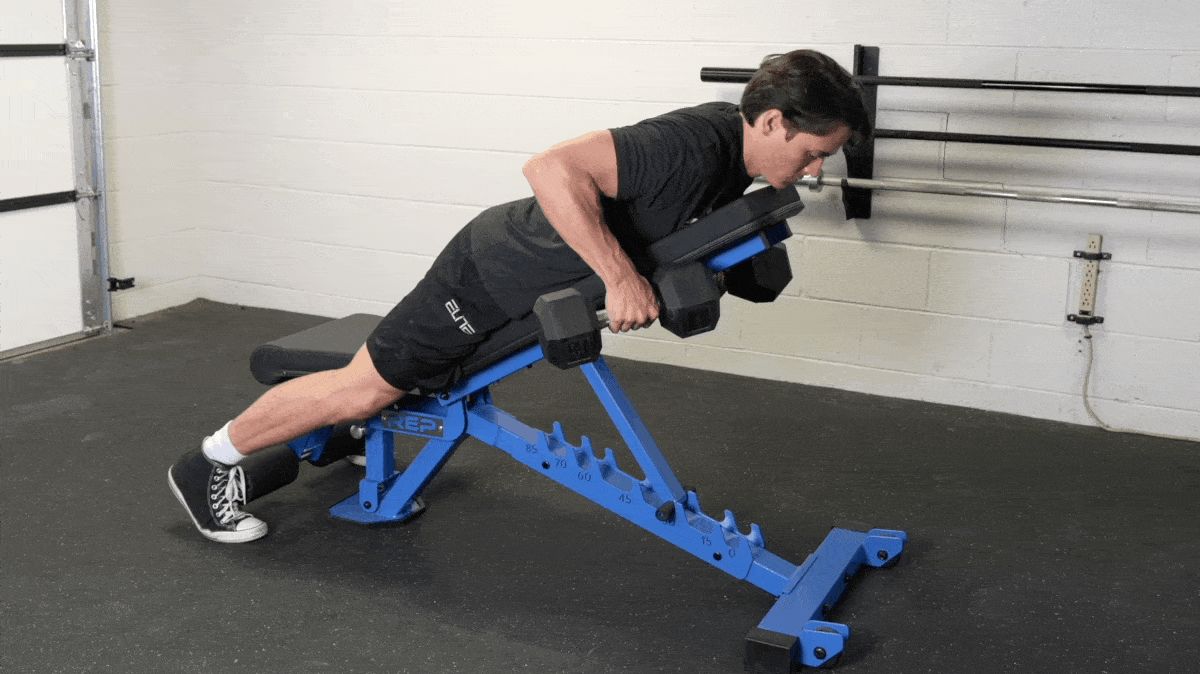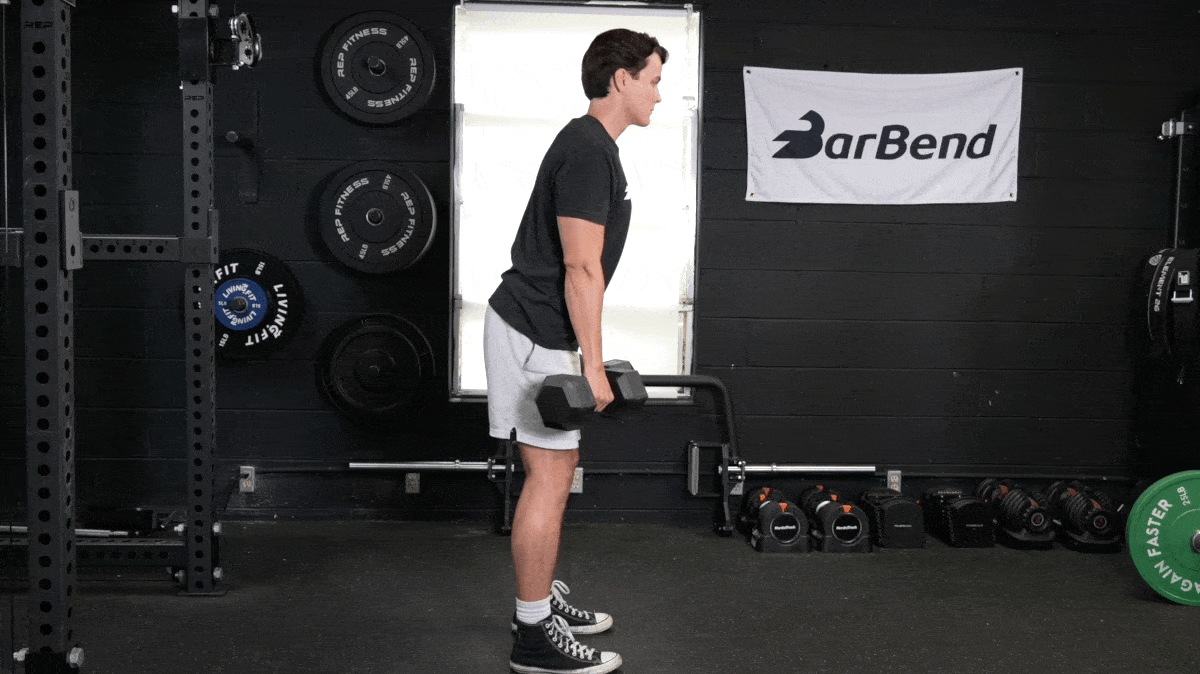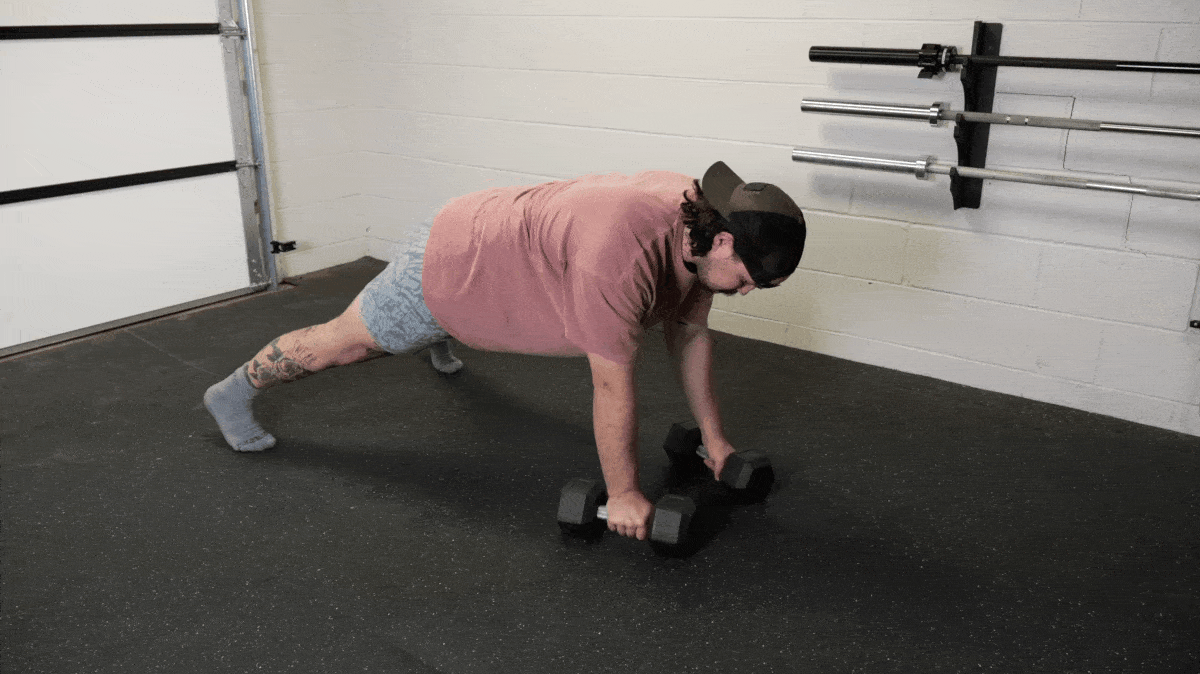Training your back isn’t just a one-exercise-and-done situation. That’s because the back contains an intricate system of muscles that support pretty much every movement in your body. If you’re bending, standing up, rotating, or twisting in any direction, a strong back is key to you moving through activities of daily life or powering through your sport of choice.
The muscles of your back support your spine and play a critical role in helping you breathe. When it comes to increasing strength and stimulating muscle hypertrophy, your back is more than just a pretty bow — it delivers the whole package. And training your back with kettlebells offers a unique set of advantages, including the gains brought on by unilateral training.

Here, you’ll learn the eight best kettlebell back exercises and how to integrate them into your program for a stronger back and heavier barbell exercises.
Best Kettlebell Back Exercises
1. Three-Point Row
If you’re looking to use kettlebells to build a stronger back, this is a great place to start. It’s especially useful for beginners. That’s because it allows you to isolate your back one side at a time to really focus on the contraction for better control and muscle stimulation.
Using a weight bench or plyo box as a prop is also a great way to get a stable base off the floor and engage your core at the same time. Get ready to get stronger and feel all the muscles of your back working together.
How to Do It:
- Place one hand and one knee on a bench, opposite foot on the floor, and a kettlebell in your free hand.
- Pull the kettlebell toward your hip, keeping your elbow close to your body.
- Keep your back straight and engage your core for stability.
- Bring the kettlebell back down without rotating your shoulders.
Coach’s Tip: Be sure the box or bench is a stable foundation for your body weight and the opposite foot can reach the floor easily.
Sets and Reps: Go with moderate to heavy weights. Aim for two to three sets of five to eight reps per side.
2. Gorilla Row
For this exercise, you will need a pair of kettlebells. They should be matching in weight, but you can also use different sizes and switch sides after each set, being sure to repeat evenly on both sides.
[Read More: Learn How to Do Picture Perfect Kettlebell Swings]
If you are using competition-style kettlebells, you may have to set your feet wider than normal. The key is to maintain a hinge position where your shins remain vertical.
How to Do It:
- Stand with your feet shoulder-width apart with the kettlebells between your ankles.
- Hinge at the hips, placing both your hands on the kettlebell handles.
- Pull one kettlebell toward your hip, with your elbow sliding past your ribcage.
- While rowing, push down through the opposite kettlebell handle into the floor.
Coach’s Tip: Keep your back flat, and squeeze your shoulder blades together at the top.
Sets and Reps: Try a moderate weight and maintain good form. Start with three or four sets of six to eight reps.
3. Chest-Supported Row
For this exercise, you’ll use a bench as a prop to support your chest during the growing movement. Two kettlebells can be used simultaneously or you can complete this exercise unilaterally, one side at a time.

[Read More: The Complete Guide to Kettlebell Training for Beginners]
To start, the bench should be placed at about a 45-degree angle. Looking for even more of a challenge? Progressively increase the incline to 30 degrees. By supporting your chest, you’ll be allowing yourself to move a lot more weight with better form.
How to Do It:
- Lie face down on an incline bench, holding a kettlebell in each hand below.
- Pull the kettlebells up toward your hips, squeezing your shoulder blades together.
- Bring the kettlebells straight down until they are hanging below your shoulders.
Coach’s Tip: Keep your neck in a neutral position and maintain a controlled pace.
Sets and Reps: Try a light to moderate weight and maintain good form. Start with three or four sets of six to eight reps. Once you’re able, increase the weight gradually but significantly to take advantage of the chest support.
4. Shrug
The shrug is a great exercise to support activities of daily living and power alike. It might not look like a lot, but you’ll develop a mighty pair of traps.

This exercise is simple but effective. By practicing both back strength and control, you’ll also be challenging your grip strength and endurance. In turn, this improved grip strength can help translate into heavier pulls all around, from deadlifts to pull-ups.
How to Do It:
- Stand with your feet hip-width apart, kettlebells in hand by your sides.
- Lift your shoulders toward your ears while squeezing your upper back, then lower them back down.
- Squeeze through your upper back, focusing on using your upper traps to avoid unnecessary neck movement.
Coach’s Tip: Brace your core, standing tall. Try not to lean, rotate, or twist throughout the movement.
Sets and Reps: Go moderate to heavy, starting with two to three sets of five to eight reps per side.
5. Renegade Row
This exercise is tough, but it will make you feel even tougher. Variations may include using only one kettlebell at a time or adding a push-up in between each rep for something a little more spicy.

[Read More: Build a Big Back and Strong Core at Once With the Renegade Row]
You’ll be increasing your shoulder and wrist stability alike by holding a plank with the kettlebell handles throughout the duration of your sets. And because you’ll have to keep your right side stabilized when your left is lifting (and vice versa), you’ll be building some pretty powerful back and core strength the whole time.
How to Do It:
- Start in a plank position with your feet a little wider than shoulder distance apart and a kettlebell in each hand.
- Align the kettlebells, making sure they are stacked directly below your shoulders.
- Row one kettlebell toward your hip while balancing on the other arm.
- Keep your body tight for more control and stability, and avoid excessive rotation.
Coach’s Tip: The wider your feet are apart, the more stable you will feel. It may also help to use competition-style kettlebells that have a larger base.
Sets and Reps: Use light to moderate weight to start with two to three sets alternating sides for eight to twelve reps.
6. Pullover
The kettlebell pullover is a challenging alternative or variation of the dead bug. This exercise strengthens your lats when they’re fully extended. Resist the urge to arch your back.
Engage your core to keep your back flat or neutral — this is a critical part of performing this movement with proper form. Keep a soft bend in your elbows throughout the entire movement, ensuring that you’re generating strength from your back and chest. Your triceps will feel this move, too — just make sure they don’t become primary movers.
How to Do It:
- Lie on your back, holding a kettlebell by the horns with both hands overhead.
- Keep your core engaged with your knees and hips bent at 90 degrees
- Lower the kettlebell behind your head until it is just above the ground. Pause, then bring it slowly back up to chest level.
Coach’s Tip: Loop your thumbs around the handle for a more secure grip while holding the kettlebell in this overhead position. The arms should always be slightly bent at the elbow, maintaining a consistent angle throughout the lift.
Sets and Reps: Start with light to moderate weight for two to three sets of eight to twelve reps.
7. Iron Cross
The kettlebell iron cross will engage your lats, traps, stabilizers, and muscles surrounding your entire shoulder girdle. Use this movement to improve your stability, which can cross over into both swinging and throwing power — not to mention overhead lifts like snatches, clean and jerks, and push presses.
[Read More: 10 Kettlebell Exercises Every Athlete Should Master]
This move is a very challenging exercise, so beginners should start with very light weights. You might even want to start off just going through the motions without weight, especially if you’re not accustomed to working with kettlebells.
How to Do It:
- Start in a standing position with your feet hip-distance apart. Have your kettlebells in each hand, in the front-rack position.
- Press one kettlebell overhead all the way up to a straight arm lockout.
- Use a tight grip and keep your elbow soft as you pull your arm down to your side with your palm facing the floor.
- Stop once your arm is outstretched and parallel to the floor.
- Pull your arm slowly back into the rack position.
- Repeat on the other arm.
Coach’s Tip: When you reach the point of form failure, slowly pull back into the front rack position. If you feel you need to drop your arms the weight is too heavy.
Sets and Reps: Start light and move slowly through two to three sets of four to six reps.
8. Deadlift
The deadlift is the go-to exercise for the posterior chain, and for good reason. With this exercise, you can build more muscle, increase power, and get stronger — all over your body. Your back is a huge player here, from supporting your core through to your lats helping hold the weight and keep it stable.
You’ll hinge at the hips and pick something up off of the ground — it’s that simple. This is one of the most common functional movement patterns. Kettlebells can help teach you to do this with excellent form and increased confidence, as well as build your strength and skill level toward taking on barbells. Learn how to use your deadlift to hip hinge your way to a more resilient back.
How to Do It:
- Stand with feet hip-width apart with the kettlebell between your ankles.
- Hinge at the hips, keeping your back neutral while pushing your hips back toward a wall or chair.
- Reach down and grab the kettlebell with your eyes forward looking toward the horizon.
- Stand up by driving your feet through the ground, squeezing your glutes, and exhaling forcefully, core tight.
- Reverse the movement without rounding your back.
Coach’s Tip: Setting the kettlebell further back between the ankles creates a deeper hip hinge. Keep your shins vertical and be careful not to let your knees come forward.
Sets and Reps: Go heavy with two to three sets of eight to ten reps.
Back Warm-Up
Warming up helps prepare your body for more intense physical activity by gradually increasing your heart rate, circulation, and body temperature. It’s important to understand that the function of the upper back and shoulders are heavily linked.
In this dynamic warm-up, you will focus on the back, but your entire upper body is involved. Give this back warm-up a try before diving into your kettlebell workouts focusing on your back.
- Jumping Jack: 3 x 30 seconds
- T-Spine Rotation: 2 x 10, repeat on both sides
- Plank to Downdog: 2 x 5
- Kettlebell Halo: 2 x 5, repeat on both sides
How to Train Your Back
Every moment, your body engages your back for movement. This means there are endless possibilities when it comes to approaching training your back.
Imagine if you had to isolate every muscle at each workout. That might make it overwhelming and sometimes you just want to know how to get it done. Use exercises that target a combination of the major muscle groups in your back simultaneously for more efficient workouts. Strategically use smaller, more specific exercises — like shrugs — to target more specific areas.
[Read More: 15 Kettlebell Moves To Improve Your Grip Strength And Stability]
If you’re a beginner, choose three to five exercises and work your way up from one set of each, twice a week, to three sets of each. Change the exercises every three to four weeks.
Kettlebell Back Exercise Selection
With so many options, variations, progressions, and customizations, it can be pretty tough to know which exercise to include in your next back workout. Here are four considerations to remember when choosing your exercises:
- Include at least one exercise that targets each area of your back — lower, middle, and upper — at each session.
- Big compound lifts, like deadlifts, should be done earlier in your workout to make sure you have enough energy.
- Consider starting with your upper back, then move down.
- Stick to the programming guidelines for your goal.
Kettlebell Back Sets and Reps
It may take a few weeks before you work your way up to the highest number of sets or — conversely — the lowest number of reps (meaning the heaviest weights).
Be sure to take your rest breaks, they are just as important as your work for you to fully meet your personal fitness goals. Here are some programming guidelines for training your back:
- For Strength: Do three to five sets of five to eight reps with one to two minutes between sets.
- For Muscle Growth: Do three to five sets of eight to 12 reps with 30 seconds to 90 seconds between sets.
- For Endurance: Do two to four sets of 12 to 20 reps with one to two minutes between sets. Rest 30 seconds to one minute between sets.
Beginners can start with just one set. No matter what your goal is, it is normal for you to start with lighter weights and fewer reps and work your way up.
Kettlebell Back Training Tips
There are no two ways around it: Your back is that important. When training your back, it’s essential to strengthen your lower, middle, and upper back muscles. You will want to use your targeted upper and lower back exercises as accessories to your bigger compound lifts that hit multiple muscle groups at the same time.
Mind-Muscle Connection Is Key
Although you can’t see your back while training, it’s important to focus on the muscle or area you are working on to get more results from your training. Creating a mind-muscle connection means focusing on the specific muscles you’re working on, aiming to feel each contraction and make it as strong as possible. This can be a tremendous asset in developing your back.
Exercise Selection Matters
Your back is one of the largest and most complex muscle groups of your body. Choose exercises with a wide range of pulling directions and grips, and include power exercises to stimulate more of your back muscles.
Technique Matters
Move through the full range of motion in multiple directions for an efficient and effective back workout. Don’t short-change your form and technique to get a few more reps, unless you’re performing cheat reps intentionally as a workout finisher technique.
Benefits of Training Your Back With Kettlebells
Training your back with kettlebells can be effective for several reasons. Kettlebell exercises provide a unique set of advantages that contribute to overall back development. Here are three benefits of back training with kettlebells.
Functional Movement Pattern
Kettlebell lifts tend to be dynamic, multi-joint movements that mimic real-life activities. Many back exercises with kettlebells engage multiple muscle groups and promote functional movement patterns. This helps improve overall coordination, stability, and mobility, which are essential components of moving effectively and efficiently in your daily life.

[Read More: 6 Fantastic Kettlebell Workouts for Burning Fat]
Spend a lot of time sitting at work or bent over your phone? Kettlebell back workouts can help bring your posture back into alignment over time.
Accessibility
You don’t need a boatload of home gym equipment or a lot of physical space to perform powerful at-home back exercises. Kettlebells are fantastic tools for getting in a back workout without having to get to the gym or set aside a lot of physical space for your workouts.
Potential Injury Prevention
Training your back may help your back become more resilient against injury. Strengthening the muscles of the back helps support the spine and may reduce the risk of issues such as herniated discs or muscle strains. It also contributes to overall joint health and stability.
Specifically training with kettlebells is especially useful because the unilateral nature of the training helps keep your strength and musculature balanced. You’ll also be contending with the off-balance nature of the kettlebells, so your stabilizer muscles will be active for sure. This can help increase stability in your overall training.
What Muscles Make Up the Back
Your appendicular skeleton consists of the upper and lower extremities, which include the shoulder girdle. Together your back muscles and shoulder girdle work to support the movement of your upper body.
There are five major muscles of your back: trapezius, latissimus dorsi, rhomboid major, rhomboid minor, and levator scapulae.
- Trapezius (Traps): The traps move the scapulae (shoulder blades) up and down while also supporting the weight of your arms
- Latissimus Dorsi (Lats): The lats are the muscles that cover your lower and mid-back. They pull the arms down and back in pulling and rowing movements.
- Rhomboid Major and Minor (Rhomboid): Both rhomboids work together to pull the scapulae toward the spine. They help stabilize your shoulder blades during arm movements.
- Levator Scapulae: These muscles run along the side and back of your neck. They elevate the scapulae, assisting in movements like shrugging your shoulders and rotating your shoulder blades downward.
More Training Content
With kettlebells, all you need is one tool and a small amount of space to give yourself a solid back workout. The best kettlebell back exercises don’t require a lot of space, and you can build immense back strength without a barbell or pull-up bar. Not too bad for a single piece of equipment.
Read on for more ways to get stronger and more muscular with kettlebells.
- The Best All-Around Kettlebell Training Program
- The Best Full-Body Kettlebell Workout, Scaled for Every Experience Level
- The Complete Guide to Kettlebell Training for Beginners
Featured Image: PeopleImages.com – Yuri A / Shutterstock
The post The 8 Best Kettlebell Back Exercises to Build Your Back Without a Barbell appeared first on BarBend.

